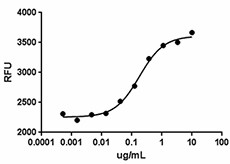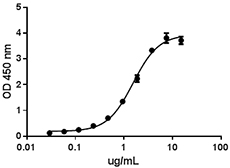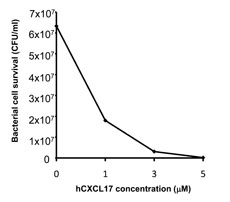- Regulatory Status
- RUO
- Other Names
- Calprotectin, Human S100A8 (Myeloid-related protein, MRP 8), S100A9 (MRP14), calgranulin A and B, L1, cystic fibrosis antigen, and 27E10 antigen, P8, MIF, NIF, CAGA, CFAG, CGLA, L1Ag, MRP8, CP-10, MA387, 60B8AG
- Ave. Rating
- Submit a Review
- Product Citations
- publications

-

Recombinant Human S100A8/A9 Heterodimer induces proliferation of astrocytes in a dose dependent manner. -

Recombinant Human S100A8/A9 Heterodimer induces proliferation of astrocytes in a dose dependent manner. BioLegend’s protein was compared side-by-side to the leading competitor’s equivalent product. -

When human S100A8/A9 heterodimer is immobilized at 5 µg/mL, RAGE-Fc Chimera binds with EC50 of 0.2 – 0.8 µg /mL in a functional ELISA. HRP Protein A (Cat. No. 689202) was used to detect the binding.
| Cat # | Size | Price | Quantity Check Availability | Save | ||
|---|---|---|---|---|---|---|
| 753404 | 25 µg | £150 | ||||
| 753406 | 100 µg | £374 | ||||
S100A8/A9, also known as Calprotectin, is a heterodimeric protein that belongs to the family of low molecular weight, calcium binding S100 proteins with two EF-hand calcium binding domains. Calcium and zinc binding influences the S100A8/A9 conformation and oligomerization state, which includes the self-assembly into homo- and heterodimers and larger oligomers. S100A8/A9 is elevated in blood and other body fluids in many pathological conditions including rheumatoid arthritis, inflammatory bowel diseases, viral or microbial infections, and tumors. S100A8/A9 is identified as an endogenous activator of TLR4 and is involved in promoting the inflammatory response in infections. Neutrophil-derived S100A8/A9 inhibits growth of Staphylococcus aureus through the chelation of manganese and zinc. S100A8/A9 is also identified as a potent amplifier of inflammation in autoimmunity as well as in cancer development and tumor spread. Injury induced by S100A8/A9 stimulates IP-10 production in monocytes and macrophages. In addition, the S100A8/A9 heterodimer also promotes astrocyte proliferation.
Product DetailsProduct Details
- Source
- Human S100A8, amino acids (Met1-Glu93) (Accession# P05109), and S100A9, amino acids (Thr2-Pro114) (Accession# P06702), were expressed in E. coli.
- Molecular Mass
- The 206 amino acid recombinant heterodimeric protein has a predicted molecular mass of approximately 23.9 kD (~11 kD for S100A8 and ~13 kD for S100A9). Under reducing conditions, the proteins migrate approximately at 9 kD (S100A8) and 13 kD (S100A9) by SDS-PAGE. The predicted N-terminal amino acids are Met (S100A8) and Thr (S100A9) for the corresponding monomers.
- Purity
- >95%, as determined by Coomassie stained SDS-PAGE.
- Formulation
- 0.22 µm filtered protein solution is in 2 mM DTT, PBS, pH 7.2.
- Endotoxin Level
- Less than 0.01 ng per µg cytokine as determined by the LAL method.
- Concentration
- 10 and 25 µg sizes are bottled at 200 µg/mL. 100 µg size and larger sizes are lot-specific and bottled at the concentration indicated on the vial. To obtain lot-specific concentration and expiration, please enter the lot number in our Certificate of Analysis online tool.
- Storage & Handling
- Unopened vial can be stored between 2°C and 8°C for up to 2 weeks, at -20°C for up to six months, or at -70°C or colder until the expiration date. For maximum results, quick spin vial prior to opening. The protein can be aliquoted and stored at -20°C or colder. Stock solutions can also be prepared at 50 - 100 µg/mL in appropriate sterile buffer, carrier protein such as 0.2 - 1% BSA or HSA can be added when preparing the stock solution. Aliquots can be stored between 2°C and 8°C for up to one week and stored at -20°C or colder for up to 3 months. Avoid repeated freeze/thaw cycles.
- Activity
- The ED50 is 0.15 - 0.6 µg/mL as measured by its ability to induce proliferation of astrocytes.
- Application
-
Bioassay
- Application Notes
-
BioLegend carrier-free recombinant proteins provided in liquid format are shipped on blue-ice. Our comparison testing data indicates that when handled and stored as recommended, the liquid format has equal or better stability and shelf-life compared to commercially available lyophilized proteins after reconstitution. Our liquid proteins are verified in-house to maintain activity after shipping on blue ice and are backed by our 100% satisfaction guarantee. If you have any concerns, contact us at tech@biolegend.com.
- Product Citations
-
Antigen Details
- Structure
- Non-covalent heterodimer.
- Distribution
-
Neutrophils, monocytes, macrophages, gingival keratinocytes, granulocytes, osteoclasts, fibroblasts, and microvascular endothelial cells.
- Function
- Pro-inflammatory molecule that possesses antimicrobial properties. Is up-regulated in neutrophils and monocytes at the sites of inflammation.
- Interaction
- Astrocytes, neutrophils, and monocytes.
- Ligand/Receptor
- RAGE and TLR4.
- Bioactivity
- S100A8/A9 Heterodimer induces the proliferation of astrocytes.
- Biology Area
- Cell Biology, Neuroscience, Stem Cells, Synaptic Biology
- Molecular Family
- Cytokines/Chemokines, Growth Factors
- Antigen References
-
1. Sampson B, et al. 2002. Lancet. 360:1742-1745.
2. Vogl T, et al. 2007. Nature Med. 13:1042-1049.
3. Semprini S, et al. 2002. Hum. Genet. 111:310-313.
4. Corbin BD, et al. 2008. Science 319:962-965.
5. Gopal R, et al. 2013. Am. J. Respir. Crit. Care Med. 188:1137-1146.
6. Siegenthaler G, et al. 1997. J. Biol. Chem. 14:9371-7.
7. Ryckman C, et al. 2003. J. Immunol. 170:3233-42.
8. Ryu MJ, et al. 2012. J. Biol. Chem. 287:22948-58.
9. Ehrchen JM, et al. 2009. J. Leuko. Biol. 3:557-66.
10. Wang J, et al. 2015. FASEB. J. 1:250-62.
11. Champaiboon C, et al. 2009. J. Biol. Chem. 284:7078. - Gene ID
- 6279 View all products for this Gene ID 6280 View all products for this Gene ID
- UniProt
- View information about S100A8/A9 on UniProt.org
Related Pages & Pathways
Pages
Related FAQs
- Why choose BioLegend recombinant proteins?
-
• Each lot of product is quality-tested for bioactivity as indicated on the data sheet.
• Greater than 95% Purity or higher, tested on every lot of product.
• 100% Satisfaction Guarantee for quality performance, stability, and consistency.
• Ready-to-use liquid format saves time and reduces challenges associated with reconstitution.
• Bulk and customization available. Contact us.
• Learn more about our Recombinant Proteins. - How does the activity of your recombinant proteins compare to competitors?
-
We quality control each and every lot of recombinant protein. Not only do we check its bioactivity, but we also compare it against other commercially available recombinant proteins. We make sure each recombinant protein’s activity is at least as good as or better than the competition’s. In order to provide you with the best possible product, we ensure that our testing process is rigorous and thorough. If you’re curious and eager to make the switch to BioLegend recombinants, contact your sales representative today!
- What is the specific activity or ED50 of my recombinant protein?
-
The specific activity range of the protein is indicated on the product datasheets. Because the exact activity values on a per unit basis can largely fluctuate depending on a number of factors, including the nature of the assay, cell density, age of cells/passage number, culture media used, and end user technique, the specific activity is best defined as a range and we guarantee the specific activity of all our lots will be within the range indicated on the datasheet. Please note this only applies to recombinants labeled for use in bioassays. ELISA standard recombinant proteins are not recommended for bioassay usage as they are not tested for these applications.
- Have your recombinants been tested for stability?
-
Our testing shows that the recombinant proteins are able to withstand room temperature for a week without losing activity. In addition the recombinant proteins were also found to withstand four cycles of freeze and thaw without losing activity.
- Does specific activity of a recombinant protein vary between lots?
-
Specific activity will vary for each lot and for the type of experiment that is done to validate it, but all passed lots will have activity within the established ED50 range for the product and we guarantee that our products will have lot-to-lot consistency. Please conduct an experiment-specific validation to find the optimal ED50 for your system.
- How do you convert activity as an ED50 in ng/ml to a specific activity in Units/mg?
-
Use formula Specific activity (Units/mg) = 10^6/ ED50 (ng/mL)
 Login / Register
Login / Register 












Follow Us